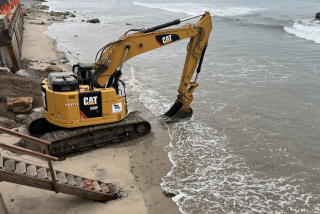The Edge’s Malibu-area project encounters setback
A rock star’s dream of building a secluded compound of homes on a ridge high above Malibu has been dealt a serious blow by state regulators who accuse U2 guitarist the Edge of trying to get around environmental rules by concealing who owns the property.
California Coastal Commission staff has recommended rejecting the musician’s plans to build five widely spaced mansions with swimming pools and commanding ocean views on the grounds that they would scar a steep, undeveloped ridgeline visible from much of the Malibu coastline, cause extensive geological disturbance and destroy environmentally sensitive native vegetation.
The agency on Wednesday granted a last-minute request by the musician and his partners to postpone a scheduled Thursday vote on their project.
The Edge — a.k.a. David Evans — has been fighting for permits to build five homes, including his own, and an access road on Sweetwater Mesa since 2006, when he and his wife bought the 156-acre property. Evans owns a home in the La Costa area of Malibu.
Environmental groups and residents of the canyons and hillsides below have lined up against the project, saying that it is out of harmony for a member of a band that has championed humanitarian and green causes and even tried to offset the carbon footprint of its tours.
But the latest disagreement between the Irish rocker and the Coastal Commission is over who owns the land. Evans and his associates contend that the project consists of five independently owned parcels and that each should be reviewed separately — a process that would make it more difficult for the agency to limit the number of homes on the site.
In a highly critical report, however, the agency accused Evans of attempting to skirt environmental regulations by asking that each home be considered separately, rather than weighing the effect of the entire compound, which they referred to as a “coordinated development scheme.”
State regulators said they concluded that Evans was the owner and controlling force behind the development and that they would probably approve only two or three smaller homes clustered in a less visible portion of the rugged parcel high above Sweetwater and Carbon canyons in the Santa Monica Mountains.
Evans’ home would be a 12,785-square-foot contemporary abode named Leaves in the Wind for the undulating green roof meant to emulate leaves fluttering on wind currents. Evans has publicized the pains he has taken to design his home and other residences to meet the highest environmental standards, using recycled and renewable materials, rainwater catchment systems, solar panels and California native landscaping.
“The California coast is a true natural treasure, and I believe in responsible design that honors such a unique location,” Evans wrote on a website, https://www.leavesinthewind.com/, set up to counter criticism of the project.
The problem, environmentalists say, is not the eco-credentials of the homes themselves, but their immense footprint atop a ridge visible from Pacific Coast Highway, Surfrider Beach, Malibu Pier and Malibu Creek State Park.
“The buildings themselves may be environmentally correct, but they’re in the wrong place,” said Mary Ann Webster, chairwoman of the Sierra Club’s Santa Monica Mountains Task Force.
In a statement, project manager Jim Vanden Berg said each home would be built on the property of a “separate and distinct owner” who is sharing the costs of an architect, landscape architect, planner and technical consultants.
“Unfortunately, staff has now taken a position that seems to want to penalize the owners for coordinating efforts,” he said.
The Coastal Commission staff conducted an extensive investigation into the ownership of the property, concluding that the owners of the five parcels, including Irish real estate investor Derek Quinlan and Evans’ wife, Morleigh Steinberg, are all connected by family or business relationships. None of the usual public documents indicating a change in property ownership — a new deed, transfer tax payment or property reassessment — has been recorded at any of the five properties, the report notes.
In interviews, Coastal Commission officials said Evans and his partners have rights as property owners to develop some portion of the site, but criticized the way that they have maneuvered to try to prevent the panel from cutting back on the number of structures.
“It’s all about money when you think about it,” said Peter Douglas, the agency’s executive director. “Rather than maybe having two houses, you get five.”
If the project were approved in its current form, Coastal Commission Deputy Director Jack Ainsworth said, it could set a precedent for other builders to place “really extreme developments” throughout the Santa Monica Mountains.
The project has been pending before the commission for several years and has been previously postponed. After the commission in 2009 expressed concerns about its effects on views, fire risk and the amount of earth that would have to be moved, Evans and his partners modified their plans, lowering building heights and backing them away from the edge in what Vanden Berg said has “resulted in nearly a complete re-design for each of the proposed houses.”
Evans and his partners haven’t indicated their next step.
More to Read
Sign up for Essential California
The most important California stories and recommendations in your inbox every morning.
You may occasionally receive promotional content from the Los Angeles Times.











